
| CAREER | 1994 Born in Fukui, JAPAN 1996 Graduated from the Sculputure class of Pacific Art School PERSONAL EXHIBITIONS: 2004 Gallery Takashi Saitoh, Ibaraki ('01) 2002 Gokase Culture Hall, Miyazaki 2000 Art Gallery Tsukuba, Ibaraki 1996 Gallery Ginga, Aomori 1988 Kinokuniya Gallery. Tokyo SELECTED GROUP EXHIBITIONS: 2005 Contemporary Art from Tsukuba. Ibaraki('03/ '01/ '99/ '97) 2004 "Ikebukuro Michi Sinsei" Social Experiment (Sunshine St.). Tokyo 2003 The 5th Exhibition of Amabiki Village and Sculpture. Ibaraki ('01/ '99/ '97) 2002 Exhibition of Contemporary Sculpture in Hyuga. Miyazaki 1990 The 2nd Festival of Modern Japan's Wood Sculptures at Seki. Gifu SYMPOSIUMS: 2000 The 1st Sculpture Symposium in Asamushi. Aomori 1998 The 3rd Pyongtaek International Art Camp. KOREA 1995 International Wood Sculpture Camp '95 in Inami. Toyama |
AMABIKI 2011 In the midst of winter
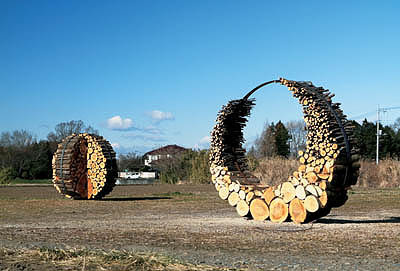
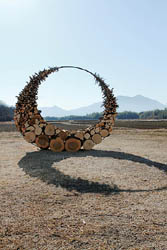
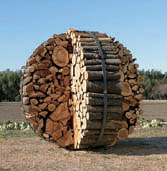
accumulation : a pile wood blossom
F.R.P.
R: 182×55×182 (h)cm
L: 200×200×200 (h)cm
The materials that are used in sculpture have their own diverse affairs and histories.
The tree I used this time is a cherry tree from our home that we needed to cut down.
For so long, our daily lives have passed in easy harmony with this tree, but now we will never see its beautiful blossoms again.
Feeling a hard-hearted moment, I gather together everything from the trunk to the branches and show everything from the inside and the outside, to create a tree's blossom.
AMABIKI 2006
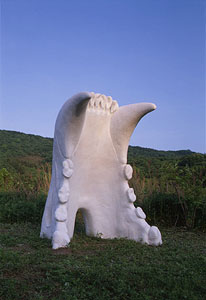
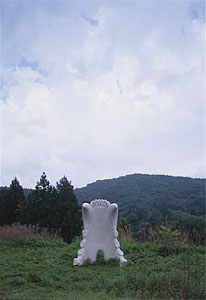
Spirit of wolf
F.R.P.
300×240×240 (h)cm
THE 5TH EXHIBITION OF AMABIKI VILLAGE AND SCULPTURE
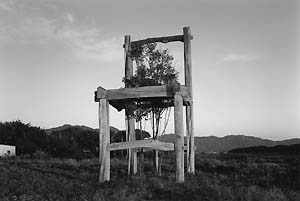
Stage of Gods
Acacia, Oak, Magnolia
270×280×500 cm
1500 kg
A stage of chair on the open land in Ohkunitama of Yamato Village. I am drawn by trees as material, and I have spent a long time using the methods of sculpture? carving, cutting, polishing, assembling, forming and so on? to express their fate in sculptures. But I should add planting to that list of tasks. I really want this relationship to be a beautiful one.
THE 4TH EXHIBITION OF AMABIKI VILLAGE AND SCULPTURE
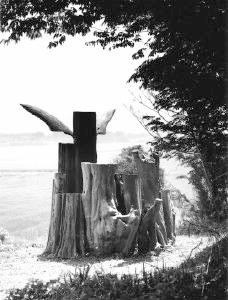
GOD HAS LEFT
Wood (Zelkova tree, Japanese cypress, Crape myrtle)
300×340×370 cm
2000 kg
The trees I used in my work were crape myrtle from Oshima, zelkova from Fukushima and sawara cypress from Ibaraki. Each type is a giant tree, centuries old, and they had finished their labors in their different regions. Combining and assembling them gave birth to a new tree from trees. If they all had decayed, they will return to the refined stage of a tree. I think that I have done an extra thing again.
THE 3RD EXHIBITION OF AMABIKI VILLAGE AND SCULPTURE
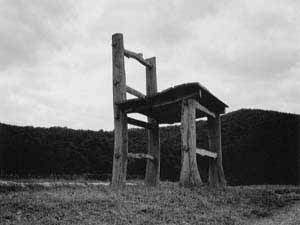
Chair of God
Zelkova
250×240×450 cm
2500 kg
THE 2ND EXHIBITION OF AMABIKI VILLAGE AND SCULPTURE
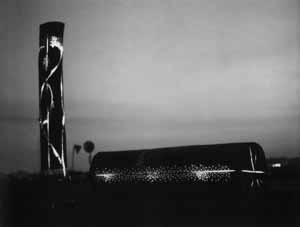
MESSAGE OF LIGHT (I AM HERE)
Wood (an oak), Lamp
90×80×300 cm, 90×200×90cm
400 kg, 300 kg



